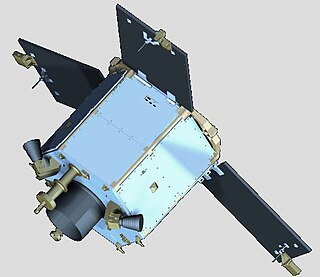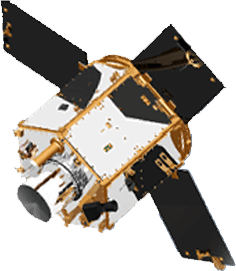
A CubeSat is a type of miniaturized satellite for space research that is made up of multiples of 10 cm × 10 cm × 10 cm cubic units. CubeSats have a mass of no more than 1.33 kilograms (2.9 lb) per unit, and often use commercial off-the-shelf (COTS) components for their electronics and structure. CubeSats are commonly put in orbit by deployers on the International Space Station, or launched as secondary payloads on a launch vehicle. Over 1000 CubeSats have been launched as of January 2019. Over 900 have been successfully deployed in orbit and over 80 have been destroyed in launch failures.
The STAR-2 Bus is a fully redundant, flight-proven, spacecraft bus designed for geosynchronous missions.

Minotaur IV, also known as Peacekeeper SLV and OSP-2 PK is an active expendable launch system derived from the LGM-118 Peacekeeper ICBM. It is operated by Northrop Grumman Innovation Systems, and made its maiden flight on 22 April 2010, carrying the HTV-2a Hypersonic Test Vehicle. The first orbital launch occurred on 26 September 2010 with the SBSS satellite for the United States Air Force.
MightySat-2.1, also known as P99-1 or Sindri was a small spacecraft developed by the Air Force Research Laboratory to test advanced technologies in imaging, communications, and spacecraft bus components in space.

DubaiSat-1 is a remote sensing Earth observation satellite built by the Emirates Institution for Advanced Science and Technology (EIAST) under an agreement with Satrec Initiative, a satellite manufacturing company in South Korea. The earth observation satellite was designed and developed by Satrec Initiative, with participation from EIAST engineers.
ITUpSAT1, short for Istanbul Technical University picoSatellite-1) is a single CubeSat built by the Faculty of Aeronautics and Astronautics at the Istanbul Technical University. It was launched on September 23, 2009 atop a PSLV-C14 satellite launch vehicle from Satish Dhawan Space Centre, Sriharikota, Andhra Pradesh in India, and became the first Turkish university satellite to orbit the Earth. It was expected to have a minimum of six-month life term, but it is still functioning for over two years. It is a picosatellite with side lengths of 10 cm (3.9 in) and a mass of 0.990 kg (2.18 lb).

Docking and berthing of spacecraft is the joining of two space vehicles. This connection can be temporary, or semipermanent such as for space station modules.
Hermes was an American satellite which was to have been operated by the Colorado Space Grant Consortium. Intended to perform technology demonstration experiments in low Earth orbit, it was lost during launch in March 2011 when the rocket that was carrying it failed to achieve orbit.
QuetzSat 1 is a Mexican high-power geostationary communications satellite which is operated by the Mexican operator QuetzSat. It is positioned in geostationary orbit, and located at 77° West, from where it provide direct broadcasting services to United States and a part of Mexico for Dish Mexico.

The Mohammed Bin Rashid Space Centre (MBRSC), encompassing the Emirates Institution for Advanced Science and Technology (EIAST) is a Dubai government organisation working on the UAE space program which includes various space satellite projects and the Emirates Mars Mission. The centre is also actively working to promote space science and research in the region.

DubaiSat-2 is an electro-optical Earth observation satellite built by the Emirates Institution for Advanced Science and Technology under an agreement with Satrec Initiative, a satellite manufacturing company in South Korea. EIAST’s objective with DubaiSat-2 is to provide electro-optical images, that can be commercialized, for users within the United Arab Emirates and beyond and to develop and implement new technologies not used in DubaiSat-1. EIAST also intends to continue manpower training for the UAE’s space program. 16 UAE engineers have been working on the design, development, testing and manufacturing of the satellite. The participation of the UAE engineers, who are currently working in South Korea, has increased by 100 per cent from the DubaiSat-1 project.
RASAT is an earth observation satellite designed and developed by TÜBİTAK Space Technologies Research Institute and produced in Turkey to provide high resolution imagery. It is so the first one of its art completely realized in Turkey, and the second indigenously developed remote sensing satellite after BILSAT-1.

NanoRacks LLC is a private company that develops products and offers services for the commercial utilization of space.
Deimos-2 is a Spanish remote sensing Earth observation satellite built for Elecnor Deimos under an agreement with Satrec Initiative, a satellite manufacturing company in South Korea.
BSAT-1a was a geostationary communications satellite designed and manufactured by Hughes on the HS-376 platform. It was originally ordered and operated by the Broadcasting Satellite System Corporation (B-SAT). It was used as the main satellite to broadcast television channels for NHK and WOWOW over Japan. It had a pure Ku band payload and operated on the 110°E longitude until it was replaced, along its backup BSAT-1b, by BSAT-3a. On 3 August 2010, it was decommissioned and placed on a graveyard orbit.

KhalifaSat is a remote sensing Earth observation satellite manufactured in the United Arab Emirates at the Mohammed bin Rashid Space Centre (MBRSC). It was the first satellite to be built in the clean rooms of the Dubai government’s space science and research facility and the first to be developed entirely by a team of Emirati engineers. It launched into orbit on 30 October 2018 from Japan's Tanegashima Space Center.
BSAT-2a, was a geostationary communications satellite operated by B-SAT which was designed and manufactured by Orbital Sciences Corporation on the STAR-1 platform. It was stationed on the 110° East orbital slot along its companion BSAT-2c from where they provided redundant high definition direct television broadcasting across Japan.
BSAT-3c, also known as JCSAT-110R, is a geostationary communications satellite operated by SKY Perfect JSAT Group (JSAT) which was designed and manufactured by Lockheed Martin on the A2100 platform.
Satrec Initiative Co., Ltd. or SI or Satrec I is a South Korean satellite manufacturing company headquartered in Daejeon, South Korea The company was founded in 1999 by the engineers who developed the first Korean satellite (KITSAT-1) at KAIST Satellite Technology Research Center (SaTRec). The company designs and builds Earth observation satellites platform called SpaceEye-series, and SI provides various space components, including high resolution electro-optical payloads and star-trackers. SI's market entering began with a Malaysian Earth observation satellite, RazakSAT. SI has two subsidiaries, SI Imaging Service (SIIS), which is the main image data provider of KOMPSAT-series and SI Detection (SID), which provides radiation monitoring solutions.











